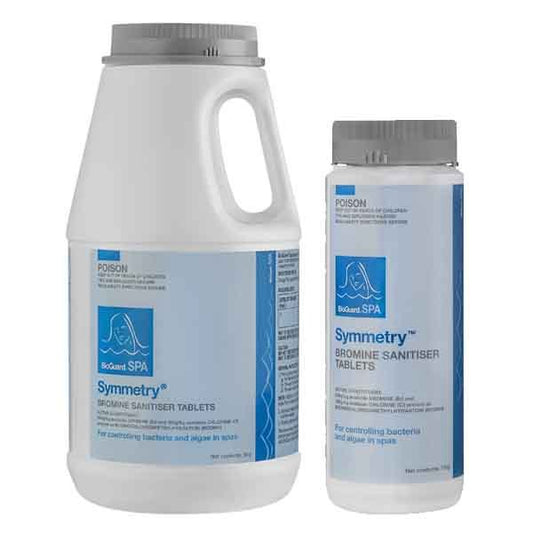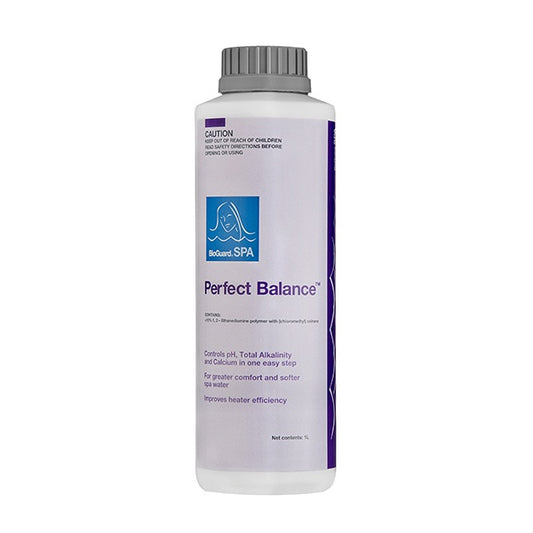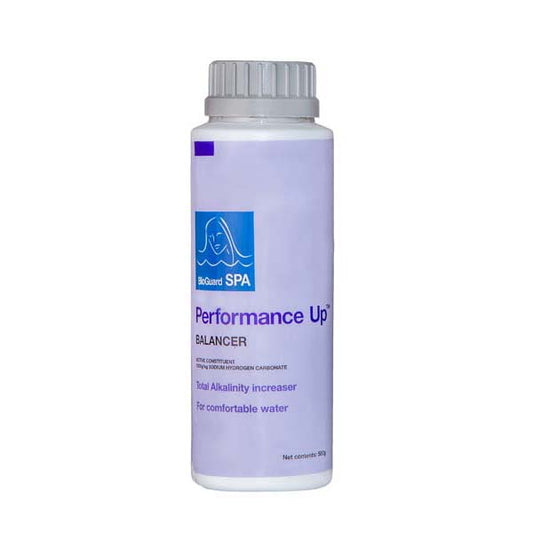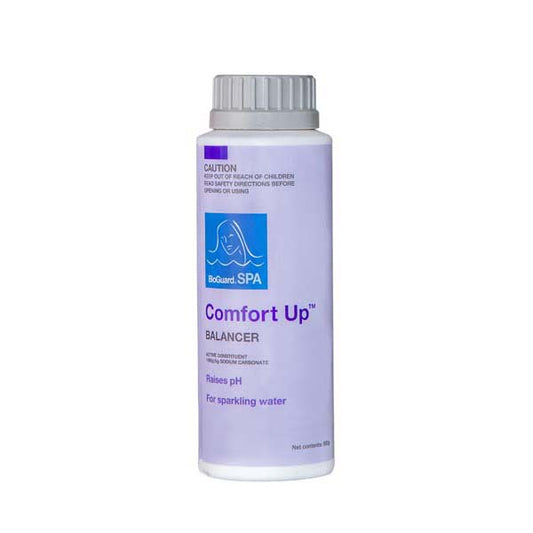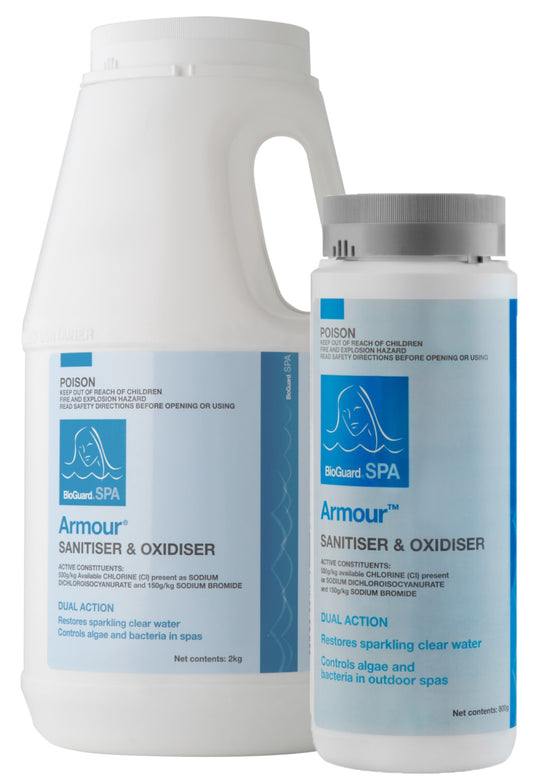CATEGORIES
-
BioGuard Symmetry (Bromine Tablets)
Regular price From $52.50 AUDRegular priceUnit price per -
BioGuard Perfect Balance 1L
Regular price $72.50 AUDRegular priceUnit price per -
BioGuard Performance Up 500g (Alkalinty Increaser)
Regular price Enquiry For PriceRegular priceUnit price per -
BioGuard Comfort Up 500g (PH Increaser)
Regular price Enquiry For PriceRegular priceUnit price per -
BioGuard Aquality (Ph Reducer)
Regular price $36.50 AUDRegular priceUnit price per -
BioGuard Armour (Sanitiser + Oxidiser)
Regular price From $59.80 AUDRegular priceUnit price per
Shop Pool Chemicals for Clean Water from Aquaman Pools
At Aquaman Pools, we're passionate about helping Aussie pool owners keep their swimming spots safe and sparkling. We know that pool chemicals can be intimidating for many people, but with the right knowledge and guidance, anyone can maintain a healthy, enjoyable swimming environment.
In this article, we'll provide expert tips on understanding pool chemicals, choosing the right chemicals for your needs, and using them safely. We'll also cover best practices for maintaining proper pool chemical balance and ensuring efficient distribution. With our guidance, you'll be well on your way to enjoying your pool all season long.
Key Takeaways:
- Pool chemicals are crucial for maintaining safe and sparkling pools in Australia
- Understanding the basics of pool chemicals is important for proper maintenance
- There are different types of pool chemicals available, each with specific functions and benefits
- Safety should always be a top priority when handling pool chemicals
- Maintaining proper pool chemical balance is key to optimal water quality
- Regular testing and maintenance are necessary for efficient chemical distribution
- Choosing the right pool chemicals for your needs is essential
Understanding Pool Chemicals
As pool owners ourselves, we understand the importance of pool chemicals in maintaining a safe and sparkling pool. Pool chemicals serve various purposes, such as sanitizing the water, balancing pH levels, and preventing algae and bacteria growth.
Chlorine is perhaps the most well-known pool chemical. It is added to the water to kill harmful microorganisms and prevent the spread of waterborne diseases. Other chemicals, such as pH adjusters, help to regulate the acidity of the water, while algaecides prevent the growth of algae. Clarifiers are used to clear up cloudy water by clumping together tiny particles that are too small to be filtered out.
It's crucial to understand that pool chemicals are not one-size-fits-all. The type and amount of chemicals needed depend on various factors, such as the size of the pool, the quality of the water, and the frequency of use. Failure to use the correct pool chemicals or use them incorrectly can lead to a host of issues, including skin irritation and discoloured water.
Testing Pool Chemical Levels
The first step in understanding pool chemicals is to test the levels regularly. Testing for pH, alkalinity, and chlorine levels is a crucial part of maintaining good water quality. The ideal pH level for pools is between 7.2 - 7.8, while the alkalinity should be between 80 - 120 ppm. Chlorine levels should be kept between 1 - 3 ppm to ensure that the water is properly sanitized.
It's a good idea to test your pool chemistry once or twice a week, depending on usage. Test strips are an easy and cost-effective way to test the water. Simply dip the strip into the pool water and compare the colours on the strip to the chart provided to determine the levels of each chemical.
By understanding the basics of pool chemicals and regularly testing the water, pool owners can maintain a clean and safe swimming environment for friends and family to enjoy.
Types of Pool Chemicals
When it comes to maintaining a safe and sparkling pool, understanding the different types of pool chemicals available is essential. There are a variety of chemicals that serve different purposes, from disinfecting the water to balancing pH levels.
Chlorine: Chlorine is the most commonly used pool chemical for disinfecting water. It kills bacteria and other contaminants that can make swimmers sick. There are several different forms of chlorine available, including tablets, granules, and liquid.
pH Adjusters: pH adjusters are used to balance the pH level of the water. A pH level between 7.2 and 7.8 is ideal for swimming pools. If the pH level is too high, the water may become cloudy and cause skin and eye irritation. If the pH level is too low, the water may become corrosive and damage the pool's surface and equipment. Common pH adjusters include sodium carbonate (pH up) and sodium bisulfate (pH down).
Algaecides: Algaecides are used to prevent and treat algae growth in the pool. They work by disrupting the algae's ability to photosynthesize, which kills the algae. Algaecides should be used regularly to prevent algae growth from occurring in the first place.
Clarifiers: Clarifiers are used to improve water clarity by removing particles that make the water cloudy. They work by causing small particles to clump together, making it easier for the filter to remove them.
It's important to note that not all pool chemicals are compatible with each other, and adding certain chemicals together can be dangerous. Always read the manufacturer's instructions and never mix chemicals unless instructed to do so.
How to Use Pool Chemicals Safely
Keeping your pool water clean and balanced is essential for a healthy swimming environment. However, it is important to handle pool chemicals with care to avoid any accidents or injuries.
Here are some tips to help you use pool chemicals safely:
- Read the instructions carefully - Always follow the manufacturer's instructions when using pool chemicals. Make sure you understand the product's purpose, dosage, and safety precautions.
- Store chemicals properly - Store pool chemicals in a cool, dry, and well-ventilated area in their original container. Keep them out of reach of children and pets.
- Handle chemicals with care - Wear protective gloves and goggles when handling pool chemicals to avoid skin or eye irritation. Do not mix different chemicals together as it can cause dangerous reactions.
- Dissolve chemicals before adding them to the pool - Always dissolve pool chemicals in a bucket of water before adding them to the pool. This helps to prevent chemical reactions and ensures even distribution.
- Don't swim immediately after adding chemicals - Wait at least 30 minutes after adding chemicals before swimming. This allows time for the chemicals to disperse and the water to circulate.
- Seek professional advice when necessary - If you are unsure about how to use a particular pool chemical or are experiencing any issues with your pool water, seek professional advice from a pool service technician or your local pool store.
By following these tips, you can maintain a clean and safe swimming environment for you and your family to enjoy. Remember, proper handling and usage of pool chemicals is key to maintaining a sparkling Aussie pool!
Maintaining Proper Pool Chemical Balance
Maintaining the proper balance of pool chemicals is crucial for ensuring safe and sparkling pool water. Here are some tips to help you keep your pool chemical balance in check:
- Test Your Pool Water Regularly: Testing your pool water regularly is essential for ensuring the proper balance of chemicals. The ideal pH level for pool water is between 7.2 and 7.8, and the ideal alkalinity level is between 80 and 120 parts per million (ppm). Chlorine levels should be maintained at 1-3 ppm. Regular testing will help you determine if adjustments need to be made to your chemical levels.
- Adjust pH Levels: If your pool water's pH level is too high or too low, it can affect the effectiveness of other chemicals in your pool. To raise your pool's pH level, use a pH increaser. To lower it, use a pH decreaser. Be sure to follow the manufacturer's instructions carefully and add chemicals slowly to prevent overcorrection.
- Add Alkalinity Increaser: If your pool water's alkalinity levels are too low, you can use an alkalinity increaser to bring them within the recommended range.
- Shock Your Pool: Shock treatments are essential for getting rid of contaminants that regular chlorine treatments can't eliminate. Shock your pool every 1-2 weeks or as recommended by the chemical manufacturer.
- Address Cloudy Water: Cloudy water is often a sign of incorrect chemical levels. If your pool water is cloudy, test the water and adjust the chemical levels as needed.
- Prevent Algae Growth: Algae thrive in conditions of low chlorine levels and high pH levels. Regularly adding algaecide to your pool can help prevent its growth. Be sure to follow the manufacturer's instructions carefully.
By following these tips, you can maintain the proper chemical balance in your pool, ensuring a safe and enjoyable swimming environment for you and your family.
Best Practices for Pool Chemical Maintenance
When it comes to maintaining your pool's chemical balance, there are some best practices that can help ensure optimal water quality and a safe swimming environment.
Regular Testing
Regularly testing your pool's chemical levels is important to maintain proper balance. We recommend testing your water at least once a week, and more frequently during periods of heavy pool use.
A pool testing kit is a valuable tool for keeping your pool's chemical levels in check. Make sure to test for pH, alkalinity, and chlorine levels, and adjust as necessary.
Shock Treatment
Regular shock treatments can help keep your pool clean and clear by eliminating contaminants and bacteria. We recommend shocking your pool once a week, but this frequency may vary based on usage and weather conditions.
When shocking your pool, make sure to follow manufacturer instructions carefully and use the appropriate amount of shock treatment for your pool size and water type.
Routine Maintenance
Regular maintenance of your pool's equipment is also important for effective chemical distribution. Make sure to clean your pool's filter and skimmer baskets regularly, and backwash your filter as needed.
It's also important to keep your pool's walls and floor clean to prevent buildup of algae and bacteria. Brushing your pool once a week and using a pool vacuum are effective ways to maintain cleanliness.
| Tip: | Be sure to wear gloves and protective eyewear when handling pool chemicals to avoid skin and eye irritation. |
|---|
By following these best practices for pool chemical maintenance, you can ensure a safe and healthy swimming environment for your family and friends.
Choosing the Right Pool Chemicals for You
With so many types of pool chemicals available, choosing the right ones for your pool can be overwhelming. But don't worry, we're here to help you make an informed decision. When selecting pool chemicals, there are a few factors to consider:
Pool Size
The size of your pool will determine how much of each chemical you need to add. Be sure to measure your pool's volume accurately before purchasing any pool chemicals.
Water Type
The type of water in your pool can also impact which chemicals you need to use. For example, if you have hard water, you may need to add a water softener to balance the pH levels.
Personal Preferences
Everyone has different preferences when it comes to the look and feel of their pool. Some people prefer a stronger chlorine smell, while others prefer a milder scent. Consider your personal preferences when selecting pool chemicals.
It's also important to purchase pool chemicals from a reputable supplier to ensure quality and effectiveness. You can find a variety of pool chemicals online or through local suppliers. To get the best price, we recommend comparing prices from different suppliers.
By taking these factors into consideration, you'll be able to choose the right pool chemicals for your needs. And remember, always follow manufacturer instructions and seek professional advice when necessary for safe and sparkling pool water.

